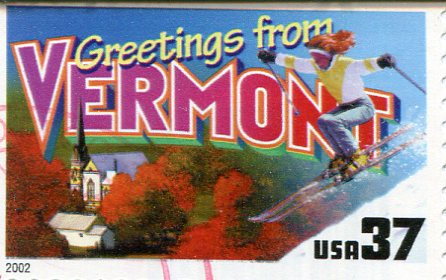Writing about as many weird and esoteric things related to our small state as I can, I suppose no directory of Vermont oddities could exist without this intriguing story, because it directly relates to how our state got the most paramount piece to our identity; our name.
The mountains east of Rutland are a beautiful sight, especially in the fall when the dense hardwood forests that climb the slopes above Route 4 are burning in autumn hues as Vermont’s mountains die gloriously for the year.
When the leaves have fallen and the slopes are dusted with snow, leaf peepers are replaced with skiers and snowboarders as they flock in mass numbers to one of the East Coast’s most prominent mountain resorts, Killington.
Even though the 2010 census recorded Killington as having a year round population of around 811, the population almost triples in the winter months as thousands pour into the numerous resorts and motels lining the illustrious mountain road that snakes its way to the resort’s doorstep.
But before skiing and flatlanders were Killington’s claim to fame, it was already finding a place in Vermont history. And this is where my story officially picks up.
In school, we were taught that Samuel de Champlain was one of the first Europeans to set foot in what is now known as Vermont in 1609, along the lake that now bears his name (It’s worth noting that Jacques Cartier was said to have set foot here before him as early as 1535).
Champlain is also first credited in suggesting the name for this new land should be les Verts Monts, or “Green Mountains” in French.
Now, enter another interesting character: Rev. Samuel Peters.
Rev. Peters came to the area from his home state of Connecticut, with the intention of bringing some spirituality to godless Vermont. He traveled around central Vermont considering it his self described altruistic mission to bring sermons and baptisms to the impoverished rural communities. Along the way, he was taken by the mysteries of the mountains.
In the southern portion of the town of Killington is Killington Peak. Rising to a lofty 4,241 feet, it is officially the second-highest point in Vermont (Mount Mansfield is the first). It was here, in 1763, where the magnificent views of perpetual rolling green hills inspired the good reverend to christen the un-organized area Verd-Mont. Peters made his claim official by symbolically smashing a bottle of whiskey on the rocky summit.
14 years later, On June 2, 1777, the local legislature convened and made “Vermont” the official name of the newly formed republic. (Vermont wasn’t granted statehood until 14 years later, in 1791.)
Peters, however, was horrified and outraged at the announcement. What the new legislature didn’t realize was that the literal translation of Vermont (Ver-Mont) in French is “maggot mountain.” (Can you imagine “The Maggot Mountain State” on our license plates?)
Peters insisted they change the spelling to Verdmont as he originally proposed, and adamantly criticized them about the adapted form of the name, saying “the state had rather be considered a mountain of worms then an evergreen mountain!”
But the legislature didn’t listen. This dismissal consumed the reverend. Driven by obsession, he made it his mission to educate people about the great travesty that was done to him (with the concern for the future name of our state apparently secondary) — despite openly ignoring the fact that Samuel De Champlain had coined “les Verts Mont” for the region 154 years before his own unofficial christening.
At this point, few were willing to listen to Peters with many avoiding him, labeling him as a raving mad man, never allowing him to bask in the accolades of pride. This is where a slightly deeper look into the mysterious Rev. Peters is needed. A clergyman from Connecticut, Peters was the first reverend to come to the area on horseback in 1763.
Despite his well intended facade, the reverend was known to be a liar. His most notable example was the time he claimed to have a doctorate from the University of Cortona in Tuscany — a university which never existed.
The reverend was, indeed, something of a con artist. In 1794, he managed to persuade his fellow clergymen into electing him the first Episcopal Bishop of Vermont, an honor the Archbishop of Canterbury refused to consecrate.
It was said that Peters was not an easy person to get along with. Certainly his status as a Tory, or British sympathizer in times of the American Revolution, didn’t make him very popular around these parts. Given this information, it adds a little depth into why some Vermonters began to turn against him.
Not much is known about the later stages of Rev. Peter’s life. He would eventually die in New York City in 1826 in poverty.
Despite his questionable history, Peter’s love for the land that is now known as Vermont was sincere.
Links/Sources:
Vermont: Records of the Governor and The State of Vermont (Google Books)
Vermont: A Guide To The Green Mountain State (Google Books)
—————————————————————————————————————————————–
To all of my amazing fans and supporters, I am truly grateful and humbled by all of the support and donations through out the years that have kept Obscure Vermont up and running.
As you all know I spend countless hours researching, writing, and traveling to produce and sustain this blog. Obscure Vermont is funded entirely on generous donations that you the wonderful viewers and supporters have made. Expenses range from internet fees to host the blog, to investing in research materials, to traveling expenses. Also, donations help keep me current with my photography gear, computer, and computer software so that I can deliver the best quality possible.
If you value, appreciate, and enjoy reading about my adventures please consider making a donation to my new Gofundme account or Paypal. Any donation would not only be greatly appreciated and help keep this blog going, it would also keep me doing what I love. Thank you!
Gofundme: https://www.gofundme.com/b5jp97d4


